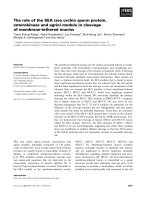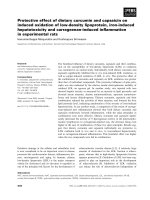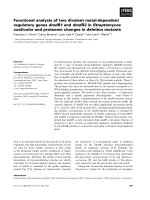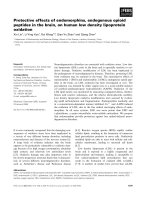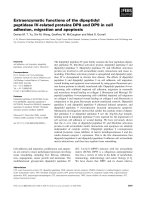Functional role of low density lipoprotein receptor related protein 5 and 6 in alzheimers disease
Bạn đang xem bản rút gọn của tài liệu. Xem và tải ngay bản đầy đủ của tài liệu tại đây (2.39 MB, 157 trang )
i
FUNCTIONAL ROLE OF LOW DENSITY LIPOPROTEIN
RECEPTOR-RELATED PROTEIN 5 AND 6 IN
ALZHEIMER’S DISEASE
ZHANG LUQI
(B.Sc. (Hons.), Xiamen University)
A THESIS SUBMITTED
FOR THE DEGREE OF DOCTOR OF PHILOSOPHY
DEPARTMENT OF PHARMACY
NATIONAL UNIVERSITY OF SINGAPORE
2014
ii
iii
DECLARATION
I hereby declare that the thesis is my original work and it has been written by me
in its entirety. I have duly acknowledged all the sources of information which
have been used in the thesis.
This thesis has also not been submitted for any degree in any university
previously.
Zhang Luqi
15 August 2014
iv
v
ACKNOWLEDGEMENTS
I want to express my deepest gratitude to my supervisor Assistant Professor Ee
Pui Lai Rachel for her guidance and support in both my research and personal
growth. She taught me how to conceptualize research projects, carry out
experiments systemically and troubleshoot problems. She also helped me improve
my scientific communication skills. Especially, she is a great teacher who cares
about students’ opinion and helps students in putting the ideas into action.
I would also like to thank my laboratory members for their scientific support and
friendship: Priti Bahety, Wang Ying, Li Yan, Jasmeet Singh Khara, Ashita Nair
and final year students who worked in our laboratory. They gave me many helpful
scientific suggestions and cheered me on when I met with difficulties in my
research. I am also thankful to Ms. Ng Sek Eng and Wong Winnie for their
technical assistance. A special appreciation is due to National University of
Singapore for giving me the NUS Research Scholarship which allowed me to
carry out the scientific pursuit.
Lastly, I would like to thank my family and friends for their support and
encouragement.
vi
vii
LIST OF PUBLICATIONS AND PRESENTATIONS
Publications and manuscripts in preparation:
1. Zhang L, Ong WQ, Ee PL. Apolipoprotein E4 disrupts normal mitochondrial
dynamics through binding to low-density lipoprotein receptor-related protein
5/6 in SH-SY5Y cells. Manuscript in preparation.
2. Zhang L, Bahety P, Ee PL. Protective role of Wnt signaling co-receptors
LRP5/6 against hydrogen peroxide-induced neurotoxicity and tau
phosphorylation in SH-SY5Y neuroblastoma cells. Manuscript in preparation.
3. Bahety P, Zhang L and Ee PL. Dihydrofolate reductase enzyme inhibition
synergizes with a glycogen synthase kinase-3β inhibitor for enhanced
neuroprotective effect in SH-SY5Y neuroblastoma cells. Manuscript in
preparation.
4. Bahety P, Tan YM, Hong Y, Zhang L, Chan CY, Ee PL. Metabotyping of
Docosahexaenoic Acid - Treated Alzheimer's Disease Cell Model. PLoS One.
2014 Feb 27;9(2):e90123.
viii
Conference Abstracts:
1. Zhang L, Ong WQ, Ee PL. Apolipoprotein E4 binds to low-density
lipoprotein receptor-related protein 5/6 and disrupts normal mitochondrial
dynamics in SH-SY5Y cells. 13
th
International Geneva/Springfield
Symposium on Advances in Alzheimer Therapy, Switzerland. 26 – 29 March
2014. Poster presentation.
2. Zhang L, Ee PL. Overexpression of LRP5 and LRP6 reduces tau
phosphorylation and overcomes neurotoxicity induced by hydrogen peroxide
through modulating Wnt signaling in SH-SY5Y. 18
th
Biological Sciences
Graduate Congress, Malaysia. 6 – 8 January 2014. Oral presentation.
3. Zhang L, Ee PL. Overexpression of LRP5/6 reduces tau phosphorylation and
improves neuronal cell survival in Alzheimer’s disease cell model. Annual
Pharmacy Research Symposium 2013, Singapore. 03 April 2013. Poster and
Oral presentation. First Prize in Abstract Presentation Contest.
4. Zhang L, Ee PL. The missing link between LRP5 and ApoEs in the
pathogenesis of Alzheimer’s Disease. Globalization of Pharmaceutics
Education Network Meeting 2012, Melbourne, Australia. 28 November to 01
December 2012. Abstract and Poster presentation.
5. Zhang L, Ee PL. The role of LRP5 in Alzheimer’s Disease. 7th
PharmSci@Asia Symposium “Exploring Pharmaceutical Sciences: New
Challenges and Opportunities”. Kent Ridge Guild House, National University
of Singapore, Singapore. 06-07 June 2012. Abstract and Poster Presentation.
ix
TABLE OF CONTENTS
SUMMARY xiv
LIST OF TABLES xviii
LIST OF FIGURES xx
LIST OF ABBREVIATIONS xxii
CHAPTER 1. INTRODUCTION 1
1.1 Alzheimer’s disease and current therapeutic approaches 1
1.2 AD classification 5
1.2.1 Early-onset AD 5
1.2.2 Late-onset AD 7
1.3 Apolipoprotein E4 8
1.3.1 Structure and function 8
1.3.2 ApoE4 neuropathology in AD 9
1.3.2.1 Effect of apoE4 on Aβ production and clearance 9
1.3.2.2 Effect of apoE4 on tau phosphorylation 10
1.3.2.3 Effect of apoE4 on mitochondrial dysfunction 10
1.3.3 Mitochondrial dynamics 12
1.3.4 Disrupted mitochondrial dynamics in AD 13
1.4 ApoE receptors 14
1.4.1 Low density lipoprotein receptor family 14
1.4.2 Low density lipoprotein-related protein 5 and 6 16
1.4.3 Dysregulated Wnt signaling in AD 20
x
1.5 Summary and concluding remarks 21
CHAPTER 2. HYPOTHESIS AND AIMS 23
CHAPTER 3. PROTECTIVE ROLE OF WNT SIGNALING CO-
RECEPTORS LRP5/6 AGAINST HYDROGEN PEROXIDE-INDUCED
NEUROTOXICITY AND TAU PHOSPHORYLATION IN SH-SY5Y
NEUROBLASTOMA CELLS 27
3.1 Introduction 27
3.2 Materials and Methods 29
3.2.1 Cell culture and reagents 29
3.2.2 Quantitative Real-Time PCR 30
3.2.3 Dual luciferase reporter assay 31
3.2.4 Western blotting analysis 32
3.2.5 Aβ25-35 and Aβ42 oligomer and fibril preparation 33
3.2.6 Cell viability analysis 34
3.2.7 Cell cycle analysis 35
3.2.8 Statistical analysis 36
3.3 Results 36
3.3.1 LRP5 and LRP6 overexpression upregulates Wnt/β-catenin signaling
and downstream proliferative genes in SH-SY5Y cells 36
3.3.2 Effect of siRNA knockdown of endogenous LRP5 and LRP6 on Wnt
signaling in SH-SY5Y cells 39
3.3.3 Generation of AD cell model with Aβ challenge 41
3.3.4 LRP5 and LRP6 overexpression rescues SH-SY5Y cells from
neurotoxicity caused by hydrogen peroxide-induced oxidative stress 47
xi
3.3.5 LRP5 and LRP6 overexpression inhibits GSK3β activity and reduces
tau phosphorylation in SH-SY5Y cells 51
3.4 Discussion 52
3.5 Conclusion 55
CHAPTER 4. CHARACTERIZATION OF THE INTERACTION
BETWEEN LRP5/6 AND APOLIPOPROTEIN E PROTEINS 56
4.1 Introduction 56
4.2 Materials and Methods 57
4.2.1 Cell culture and reagents 57
4.2.2 Mutagenesis 58
4.2.3 Bacterial transformation 59
4.2.4 Restriction enzyme digestion 60
4.2.5 Agarose gel electrophoresis 60
4.2.6 Western blotting analysis 61
4.2.7 Co-immunoprecipitation 61
4.2.8 Dual luciferase reporter assay 62
4.2.9 Statistical analysis 62
4.3 Results 62
4.3.1 Site-directed mutagenesis of pCMV.–apoE2 to generate pCMV.–
apoE3 62
4.3.2 LRP5 and LRP6 interact with all three apoE isoforms 66
4.3.3 The interaction between LRP5 and apoE isoforms disrupts the
activation ability of LRP5 68
4.3.4 Effect of the interaction between LRP5 and apoE isoforms on GSK3β
activity 69
4.4 Discussion 70
4.5 Conclusion 73
xii
CHAPTER 5. APOLIPOPROTEIN E4 DISRUPTS NORMAL
MITOCHONDRIAL DYNAMICS THROUGH BINDING TO LOW-
DENSITY LIPOPROTEIN RECEPTOR-RELATED PROTEIN 5/6 IN SH-
SY5Y CELLS 75
5.1 Introduction 75
5.2 Materials and Methods 78
5.2.1 Cell culture and reagents 78
5.2.2 Polymerase Chain Reaction (PCR) 78
5.2.3 Restriction enzyme digestion 79
5.2.4 Alkaline phosphatase digestion 79
5.2.5 Agarose gel electrophoresis 80
5.2.6 Gel extraction 80
5.2.7 DNA ligation 81
5.2.8 Bacterial transformation 81
5.2.9 Western blotting analysis 81
5.2.10 Co-immunoprecipitation 82
5.2.11 Confocal fluorescence microscopy 82
5.2.12 Mitochondrial morphology analysis 83
5.2.13 Colocalization analysis 83
5.2.14 Detection of mitochondrial transmembrane potential 84
5.2.15 Statistical analysis 85
5.3 Results 85
5.3.1 Molecular cloning of apoE4 fragment plasmid 85
5.3.2 Overexpression of apoE4 and apoE4 fragment perturbs mitochondrial
dynamics 87
xiii
5.3.3 ApoE4 and apoE4 fragment interact with LRP5/6 89
5.3.4 DKK1 disrupts the interaction between apoE4 and LRP5/6 in a dose-
dependent manner 93
5.3.5 Dissociation of apoE4 and LRP5/6 restores perturbed mitochondrial
dynamics 96
5.3.6 Knockdown of LRP5/6 abolishes apoE4-induced disruption in
mitochondrial dynamics 100
5.3.7 Overexpression of apoE4 does not affect mitochondrial transmembrane
potential 102
5.4 Discussion 103
5.5 Conclusion 106
CHAPTER 6. CONCLUSION AND FUTURE PERSPECTIVES 108
BIBLIOGRAPHY 115
APPENDICES 129
xiv
SUMMARY
Alzheimer’s disease (AD) is the most common type of dementia for the elderly
and is the sixth-leading cause of death in the U. S The complete mechanism of
AD still remains unclear and currently there is no effective disease-modifying
drug to delay or cure this disease. Although aberrant Wnt inhibition has been
implicated in AD pathogenesis, the role of Wnt co-receptors low density
lipoprotein receptor-related protein (LRP) 5 and LRP6 has yet to be established.
Thus, the overall goal of this study is to explore the functional role of LRP5 and
LRP6 in AD. Herein we explored two different objectives:
(1) To assess the protective role of LRP5 and LRP6 against hydrogen peroxide-
induced neurotoxicity and tau phosphorylation.
(2) To investigate the effect of LRP5 and LRP6 on apolipoprotein (apo) E4-
induced abnormalities in mitochondrial dynamics.
In the first part, we showed that the overexpression of LRP5 and LRP6 activated
Wnt signaling in SH-SY5Y cells which was evidenced by elevated T-cell specific
transcription factor/lymphoid enhancer factor 1 (TCF/LEF) reporter activities and
increased β-catenin protein levels. The transcription of downstream survival
xv
genes Axin2 and Cyclin D1 is consequently increased. On the other hand,
knockdown of LRP5 and LRP6 in SH-SY5Y cells resulted in a decrease in
Wnt/β-catenin activity and a reduction in survival gene expression. We further
demonstrated that overexpression of LRP5 and LRP6 protected SH-SY5Y cells
from cell death caused by hydrogen peroxide-induced oxidative stress. In addition,
this overexpression significantly suppressed the activity of GSK3β and resulted in
the reduction of tau phosphorylation. In the second part, we established the direct
interaction between apoE isoforms and LRP5/6. We observed that the interaction
between apoE isoforms and LRP5 disrupted the activation ability of LRP5 and
exerted isoform-specific effects on GSK3β activity. Furthermore, we
demonstrated the detrimental effect of apoE4 in causing mitochondrial dynamics
disruption with the aberrantly increased expression of mitochondrial fission
proteins, dynamin-related protein 1 (Drp1) and mitochondrial fission 1 (Fis1), and
decreased expression of mitochondrial fusion protein mitofusin (Mfn) 2.
Subsequently, the changes in mitochondrial morphology towards fission were
observed. In addition, we identified dickkopf (DKK) 1 as the inhibitor to disrupt
the interaction between apoE4 and LRP5/6. Subsequent disruption of apoE4 and
LRP5/6 interaction by DKK1 resulted in a reduction of the elevated mitochondrial
fission proteins and an increase of the repressed mitochondrial fusion protein,
followed by the restoration of normal mitochondrial dynamics. In conclusion, our
data not only indicated the functional role of LRP5 and LRP6 in AD, but also
xvi
provided a better understanding in the mechanisms underlying apoE4-induced AD
pathology. With further characterization and studies, LRP5 and LRP6 may
potentially be explored as the novel therapeutic targets for treating AD.
xvii
xviii
LIST OF TABLES
Table 1-1. Disease-modifying treatments targeting Aβ. 3
Table 3-1 Primers used to determine the mRNA levels of GAPDH, Cyclin D1 and
Axin2 31
Table 4-1 Primers used for site-directed mutagenesis from apoE2 to apoE3 58
Table 4-2 Reagents used for mutagenesis 59
Table 4-3 Primers used for sequencing pCMV.apoE3. 66
Table 5-1 Primers used for amplification of apoE4 fragment 78
Table 5-2 Reagents used for PCR amplification 79
Table 5-3 Statistical analysis of the degree of colocalization between apoE4 and
LRP5. 93
Table 5-4 Statistical analysis of the degree of colocalization between apoE4 and
LRP6. 93
xix
xx
LIST OF FIGURES
Figure 1-1. Amyloidogenic and non-amyloidogenic processing of APP 6
Figure 1-2. The structure of apoE and the meta-analysis on the populations of
people with apoE isoforms 7
Figure 1-3. The structure of LDL receptor family members. 16
Figure 1-4. Schematic representation of the canonical Wnt/ β-catenin signaling
pathway 19
Figure 3-1. LRP5 and LRP6 overexpression upregulates Wnt/β-catenin signaling
and downstream proliferative genes in SH-SY5Y cells. 38
Figure 3-2. Knockdown of LRP5 or LRP6 in SH-SY5Y human neuroblastoma
cells supresses Wnt signaling and the transcription of downstream proliferation
markers. 41
Figure 3-3. Generation of AD cell model with Aβ challenge. 46
Figure 3-4. LRP5 and LRP6 overexpression rescues SH-SY5Y cells from
neurotoxicity caused by hydrogen peroxide-induced oxidative stress. 50
Figure 3-5. LRP5 and LRP6 overexpression inhibits GSK3β activity and reduces
tau phosphorylation in SH-SY5Y cells. 52
Figure 4-1. Site-directed mutagenesis of pCMV.–apoE2 to generate pCMV.–
apoE3. 65
Figure 4-2. Detection of the interaction between apoE isoforms and LRP5/6. 67
Figure 4-3. The interaction between LRP5 and apoE isoforms disrupts the
activation ability of LRP5. 68
Figure 4-4. Effect of the interaction between LRP5 and apoE isoforms on GSK3β
activity 70
Figure 5-1. Schematic representation of mitochondrial fusion and fission
processes. 76
Figure 5-2. Molecular cloning of apoE4 fragment plasmid. 87
xxi
Figure 5-3. ApoE4 and apoE4 fragment induce abnormalities in mitochondrial
dynamics. 89
Figure 5-4. Detection of the interaction between apoE4/apoE4 fragment and
LRP5/6. 92
Figure 5-5. DKK1 disrupts the interaction between apoE4 and LRP5/6 in both
HEK293T cells and SH-SY5Y cells. 96
Figure 5-6. Dissociation of apoE4 and LRP5/6 restores perturbed mitochondrial
dynamics back to normal. 99
Figure 5-7. Knockdown of LRP5/6 abolishes apoE4-induced disruption in
mitochondrial dynamics. 101
Figure 5-8. Overexpression of apoE4 does not affect mitochondrial
transmembrane potential. 103
xxii
LIST OF ABBREVIATIONS
AD
Alzheimer’s disease
APC
adenomatous polyposis coli
apoE
apolipoprotein E
apoER2
apolipoprotein E receptor 2
APP
amyloid precursor protein
AR
Aspect Ratio
Arg
Arginine
Aβ
β-amyloid
BLAST
Basic Local Alignment Search Tool
BSA
bovine serum albumin
C83
C-terminal fragment 83
C99
C-terminal fragment 99
CIP
Calf Intestinal Alkaline Phosphatase
CK1
casein kinase 1
CNS
central nervous system
Cys
cysteine
ddH
2
O
double-distilled H
2
O
DKK
dickkopf
DMEM
Dulbecco’s modified Eagle medium
Drp1
dynamin-related protein 1
Dvl
dishevelled
EGF
epidermal growth factor
EOAD
early-onset Alzheimer's disease
FBS
fetal bovine serum
xxiii
FF
Form Factor
Fis1
mitochondrial fission 1
fz
frizzled
GBP
glycogen synthase kinase 3 binding protein
GSK
glycogen synthase kinase
GWAS
genome-wide association study
HDAC
histone deacetylase
IB
immunoblotting
IP
immunoprecipitation
LCM
control L-cell conditioned medium
LDL
low density lipoprotein
LOAD
late-onset Alzheimer's disease
LRP
low density lipoprotein receptor-related protein
L-Wnt-3a cells
L-cells stably transfected with a Wnt-3a expression factor
Mff
mitochondrial fission factor
Mfn
mitofusin
miniprep
minipreparation
mtDNA
mitochondrial DNA
MTT
3-(4,5-dimethylthiazol-2-yl)-2,5-diphenyltetrazolium bromide
NCBI
National Center for Biotechnology Information
NFT
neurofibrillary tangle
OPA1
optic atrophy 1
PBS
phosphate buffer saline
PCC
Pearson’s correlation coefficient
PCR
Polymerase Chain Reaction
PI
propidium iodide
xxiv
PSEN
presenilin
ROS
reactive oxygen species
S.E.M.
standard error of the mean
sAPPα
soluble APP fragment α
sAPPβ
soluble APP fragment β
Ser
Serine
siRNA
double stranded short interfering RNA
SNP
single nucleotide polymorphism
SorLA/LR11
sorting protein-related receptor/lipoprotein receptor 11
STS
staurosporine
TAE
Tris-Acetate-EDTA
TBST
Tris Buffer Saline with 0.1% Tween 20
TCF/LEF
T-cell specific transcription factor/lymphoid enhancer-binding factor 1
WCM
Wnt3a-conditioned medium
ΔΨm
mitochondrial transmembrane potential
xxv


